Raw Food Ingredients
Oracacao: The Ultimate Superfood
Discover the hidden powers of Oracacao, the ultimate superfood, and uncover a world of health benefits and delicious recipes.
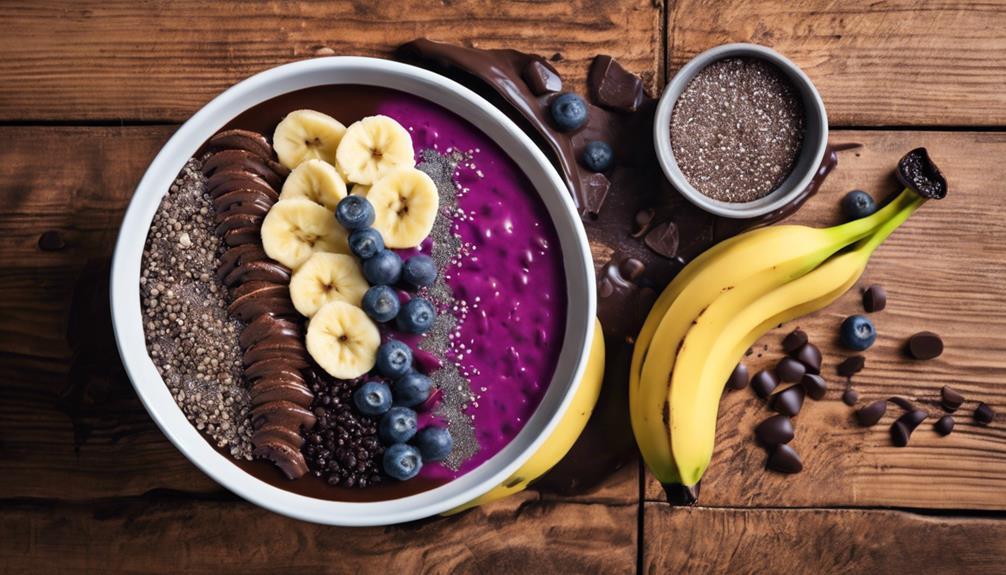
Oracacao, the ultimate superfood, is a powerhouse of health benefits, vitality, and rich nutrients. This organic and ethically traded superfood is a sustainable and wholesome choice from small farms in Belize, Colombia, Guatemala, and Tanzania.
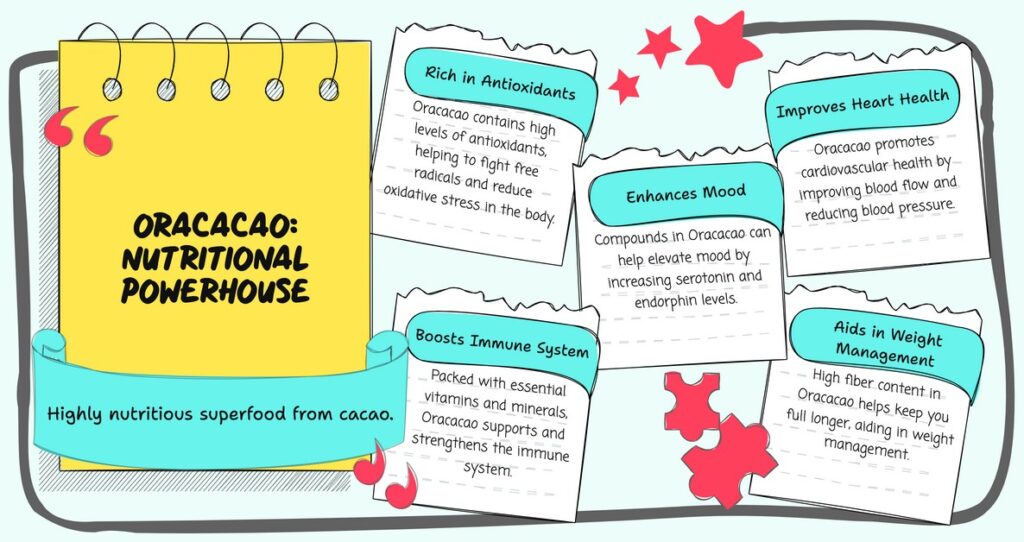
Its unique ceremonial uses, ethical sourcing practices, and delicious recipes make it a versatile option for starting the day positively, finding tranquility in the afternoon, or reflecting in the evening. Experiment with flavor pairings like cinnamon, chili, and raspberry to elevate the taste and nutritional benefits of Oracacao. If you are curious about its nutritional profile or where to purchase it, there’s much more to discover.
Key Takeaways
- Oracacao is a superfood with rich nutrients and antioxidants.
- It provides a natural energy boost and enhances well-being.
- Sourced ethically from small farms in various regions.
- Organic certified, free from additives or preservatives.
- Supports sustainable trading practices and fair compensation for farmers.
Health Benefits of Oracacao
Oracacao provides a multitude of health benefits, enhancing well-being and vitality through its pure, organic cacao composition. Raw cacao, the primary ingredient in Oracacao, is known for its rich nutrients and antioxidants.
This ceremonial cacao is ethically traded, ensuring that every sip not only nourishes your body but also supports sustainable practices. The energy boost from Oracacao comes from the natural properties of cacao, which can help improve focus and mood.
Unlike processed chocolates, Oracacao is artisanal, meaning it’s carefully crafted in small batches to preserve the integrity of the cacao beans.
Ethical Sourcing Practices
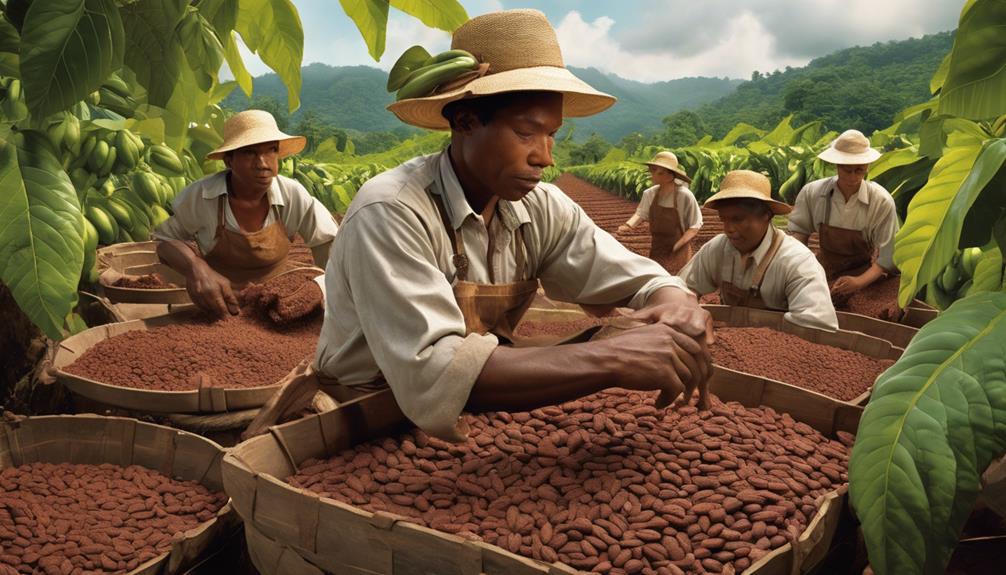
With a dedication to supporting small cacao farming communities, Firefly Chocolate LLC guarantees that ethical sourcing practices are at the heart of their production of Oracacao ceremonial cacao. The cacao beans used in Oracacao are meticulously selected from small farms in Belize, Colombia, Guatemala, and Tanzania, ensuring that these communities receive fair compensation for their hard work. In addition, all the cacao utilized is organic certified, meeting stringent quality standards while being ethically traded to promote sustainability in the industry. By focusing on responsible sourcing, Oracacao not only delivers a high-quality product but also contributes to the well-being of cacao farming communities worldwide. Each batch of Oracacao ceremonial cacao is freshly made for ceremonial purposes, containing no additives or preservatives, allowing consumers to experience the pure essence of this superfood. Below is a table highlighting the key aspects of Oracacao’s ethical sourcing practices:
Key Aspect Description Cacao Bean Source Small farms in Belize, Colombia, Guatemala, Tanzania Certification Organic certified Trading Practices Ethically traded Community Support Supports small cacao farming communities Additives No additives or preservatives
Nutritional Profile Overview
Crafted with care from whole raw cacao beans, the nutritional profile of Oracacao ceremonial cacao offers a glimpse into the health benefits of this ultimate superfood. This organic certified and ethically traded cacao is pure and free from additives, ensuring an authentic experience.
Sourced from small farms in Belize, Colombia, Guatemala, and Tanzania, Oracacao is an artisanal product created by Firefly Chocolate LLC specializing in small-batch chocolate making. Packed with antioxidants, minerals, and vitamins, ceremonial cacao made from these quality cacao beans can support overall well-being.
It’s a perfect addition to seasonal celebrations, providing a unique way to connect with the changing seasons mindfully. The richness and depth of flavor in this ceremonial cacao also reflect the care and attention given to its production, making each cup a special experience to savor.
Unique Ceremonial Uses
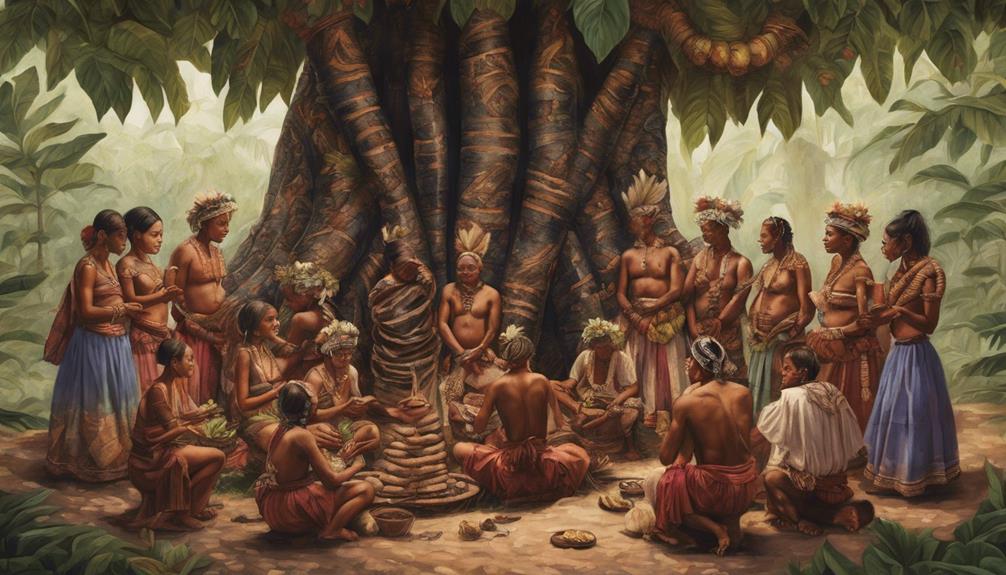
Ceremonial uses of Oracacao are rooted in their ritual significance, cultural traditions, and spiritual connections. These practices hold deep meaning within various communities and are passed down through generations to honor the cacao’s sacred nature.
Understanding the unique ceremonial uses of Oracacao enhances our appreciation for this superfood’s role beyond just nutrition.
Ritual Significance
In the domain of sacred practices, the distinctive ceremonial uses of Oracacao bring a profound depth to spiritual rituals. When engaging in ceremonial practices with this special cacao, consider the following:
- Crafted with Care: Each batch is meticulously prepared from whole raw cacao beans, ensuring the utmost quality for your ritualistic purposes.
- Sourced Sustainably: The cacao used is organic certified and ethically traded, supporting small farms in regions like Belize, Colombia, Guatemala, and Tanzania.
- Pure and Additive-Free: Oracacao is freshly made without any additives or preservatives, maintaining its purity and potency for ceremonial use.
- Produced by Experts: Firefly Chocolate LLC in Graton, CA, is dedicated to creating this ceremonial cacao, ensuring a blend that resonates with the spirit of your rituals.
Cultural Traditions
Indigenous communities across various regions have long embraced unique ceremonial uses of Oracacao, integrating this sacred cacao into traditional practices that foster spiritual connections and inner exploration.
Ceremonial cacao, crafted from whole raw cacao beans, holds a special place in the hearts of these communities. It’s sourced from small farms in Belize, Colombia, Guatemala, and Tanzania, ensuring its organic and ethical origins. Used for centuries in traditional rituals, ceremonial cacao enhances mindfulness, emotional well-being, and inner reflection.
Its pure form, free from additives or preservatives, maintains its authenticity. Through ceremonies and sacred practices, indigenous cultures have valued ceremonial cacao for its ability to deepen spiritual connections, promote mindfulness, and support emotional well-being.
Spiritual Connections
Regularly intertwined with ancient customs and modern spiritual practices, the ceremonial use of Oracacao’s cacao cultivates profound connections to the divine within.
When engaging in ceremonies with Oracacao’s ceremonial cacao, one may experience a heightened sense of spiritual awareness and clarity.
The organic certified and ethically traded cacao beans used by Oracacao are carefully sourced from small farms in Belize, Colombia, Guatemala, and Tanzania, ensuring a sustainable and sacred experience.
Firefly Chocolate LLC, the producer based in Graton, CA, meticulously crafts each batch, free from additives or preservatives, to preserve the purity of the ceremonial cacao.
Oracacao Vs Regular Cacao
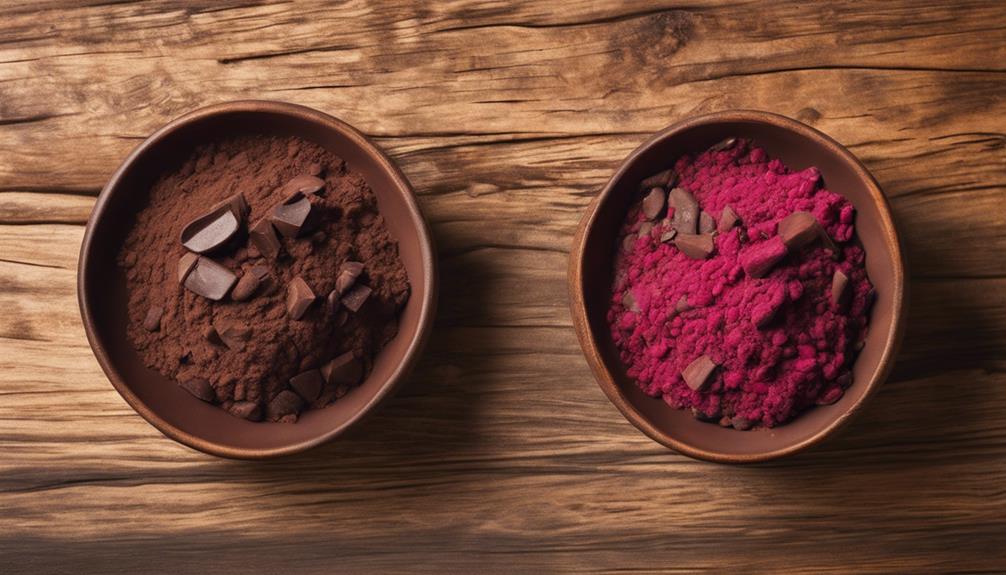
Crafted in small batches from whole raw cacao beans, Oracacao offers a unique ceremonial experience compared to traditional cacao products. Oracacao is organic certified and ethically traded, ensuring a superior quality product free from additives or preservatives. Sourced from small farms in Belize, Colombia, Guatemala, and Tanzania, this superfood is meticulously processed by Firefly Chocolate LLC in Graton, CA, United States.
To better illustrate the distinctions between Oracacao and regular cacao, let’s explore the table below:
| Oracacao | Regular Cacao |
|---|---|
| Ceremonial purposes | Baking or cooking |
| Ethically traded | Mass-produced |
| Organic certified | May contain additives |
| Crafted in micro batches | Often processed in large quantities |
Embracing Oracacao means embracing a connection to the earth and the cacao bean’s rich history, elevating your ceremonial experience to new heights.
Customer Testimonials and Reviews
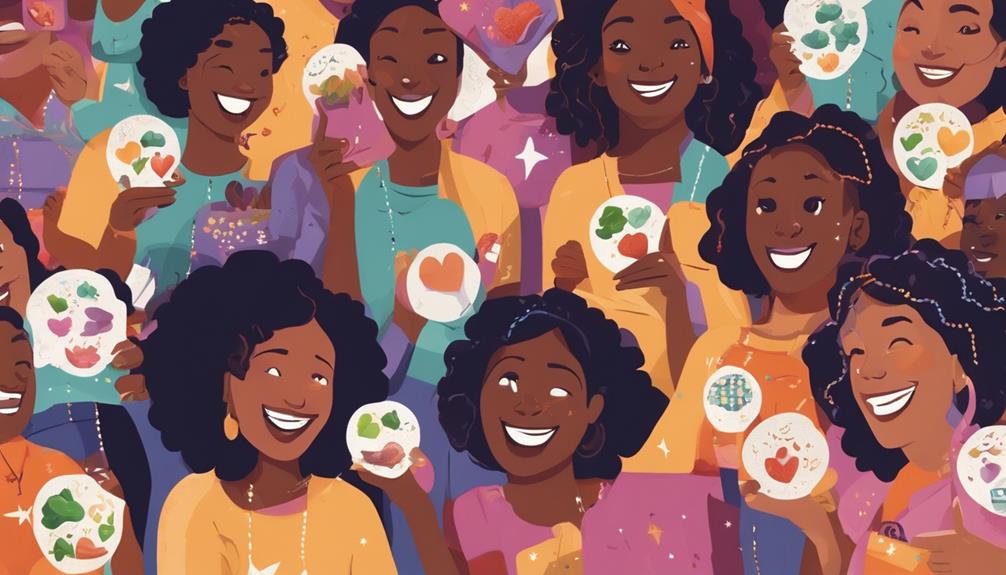
I found the customer testimonials and reviews to be overwhelmingly positive, highlighting the energizing effects and smooth energy provided by Oracacao. The feedback from users like Lauren B., Bhagavan M., Charlaine S., Jeff R., and Suzette S. showcases the diverse experiences with this superfood product.
Here are some key takeaways from their reviews:
- Energizing Effects: Users reported feeling a boost in energy without experiencing jittery side effects, making Oracacao a great alternative to traditional caffeinated beverages.
- Taste and Texture: Jeff R.’s positive review emphasized that Oracacao met expectations with regard to taste and texture, indicating a pleasant sensory experience.
- Improved Focus: Suzette S. noted improved focus and energy levels after consuming Oracacao, suggesting potential cognitive benefits beyond mere physical energy.
- Dosage Caution: It’s crucial to heed Suzette S.’s advice on dosage caution due to health concerns, emphasizing the importance of following recommended consumption guidelines for a safe and effective experience with Oracacao.
Sustainability Initiatives

After exploring the glowing customer testimonials and reviews of Oracacao, it becomes evident that the brand’s dedication to sustainability is just as remarkable. Oracacao sources its ceremonial cacao from small farms in Belize, Colombia, Guatemala, and Tanzania, supporting local communities and promoting sustainable cacao production.
The brand guarantees the freshness and quality of their ceremonial cacao by crafting it in micro batches from whole raw cacao beans. Additionally, Oracacao’s production process is organic certified and ethically traded, emphasizing sustainability and fair practices. By being free from additives or preservatives, the ceremonial cacao maintains its purity and natural flavors, providing consumers with a truly authentic experience.
This commitment to sustainability extends beyond just the final product; Oracacao supports small farmers through their sourcing practices, further contributing to the ethical and environmentally conscious ethos of the brand.
Incorporating Oracacao Into Daily Routine
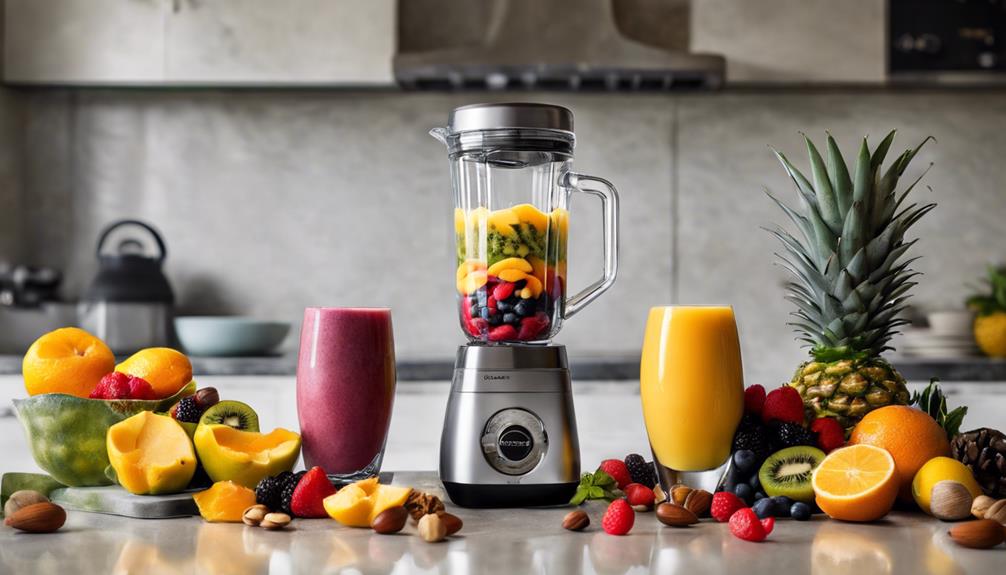
Indulging in Oracacao daily can elevate your routine with a touch of luxury and wellness. This exquisite drinking chocolate, sourced from small farms in various countries, isn’t just a treat but a way to infuse your day with a sense of ceremony and spiritual connection.
Here are four ways to seamlessly incorporate Oracacao into your daily life:
- Morning Ritual: Start your day with a warm cup of Oracacao to set a positive tone for the hours ahead. Let the rich flavors of the organic certified cacao beans awaken your senses and prepare you for the day.
- Afternoon Delight: Take a break in the afternoon and savor a moment of tranquility with a soothing mug of Oracacao. Allow its artisanal chocolate goodness to bring you a moment of relaxation amidst your busy schedule.
- Evening Wind-Down: As the day comes to a close, indulge in a cup of Oracacao to unwind and reflect. Let its ceremonial purpose enhance your spiritual practices and promote a peaceful night’s rest.
- Creative Inspiration: Use Oracacao as a companion during your creative endeavors. The unique blend of cacao can stimulate your imagination and foster innovative thinking in your daily routine.
Oracacao Recipes and Pairings
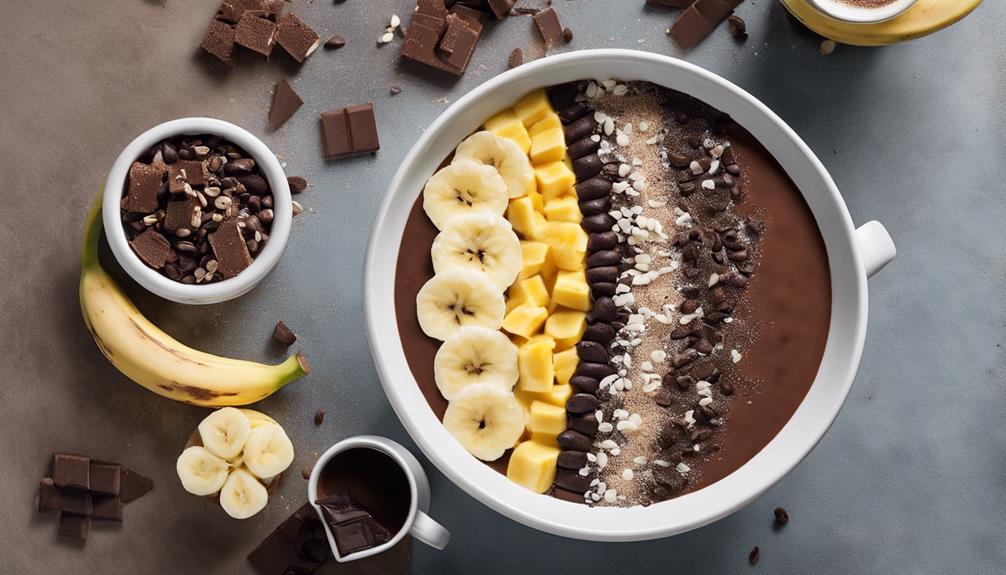
Oracacao offers a wide array of delicious recipes that can take your cacao experience to the next level.
Pairing Oracacao with plant-based milk or water creates a delightful and flavorful drink that can be enjoyed at any time.
Tasty Oracacao Recipes
Exploring tasty Oracacao recipes opens up a world of culinary possibilities that enhance the rich and nutty flavors of this superfood. Here are some key points to bear in mind when delving into Oracacao recipes:
- Variety: Oracacao recipes range from hot chocolate to smoothies, offering a diverse range of options for different tastes.
- Ingredients: These recipes often include plant-based milk, sweeteners, spices, and superfoods to create indulgent treats that boost the benefits of Oracacao.
- Versatility: Oracacao recipes cater to various preferences and occasions, making it easy to incorporate this superfood into daily routines.
- Enjoyment: By trying out Oracacao recipes, individuals can discover new and delightful ways to enjoy the taste and benefits of this nutritious superfood.
Perfect Flavor Pairings
Enhance your culinary creations with the perfect flavor pairings for Oracacao recipes. When it comes to pairing cacao, think beyond traditional combinations. Experiment with spices like cinnamon and chili for a kick of warmth, or try fruits like orange or raspberry for a fruity twist.
Nuts such as almonds or hazelnuts can add a satisfying crunch, while herbs like mint or lavender introduce an invigorating element. These flavor pairings not only elevate the taste of your dishes but also enhance the nutritional benefits of cacao.
Whether you’re preparing savory meals or sweet treats, incorporating these creative ideas into your recipes will showcase cacao as the ultimate superfood for both your culinary creations and drinks.
Creative Serving Ideas
With a dash of creativity, my cacao-infused recipes come to life through unique flavor pairings and innovative serving ideas.
- Enhance your cacao experience by experimenting with Oracacao recipes for hot cacao elixirs, cacao smoothie bowls, or cacao-infused desserts.
- Elevate your cacao ritual with Oracacao’s serving suggestions, such as adding herbs or adaptogens to your creations.
- Discover the perfect pairings for Oracacao by combining it with ingredients like cinnamon, chili, or coconut sugar for delightful flavor combinations.
- Take your cacao tasting experience to the next level by exploring Oracacao pairings with fruits, nuts, or artisanal cheeses for a gourmet twist.
Oracacao: Where to Purchase

To acquire Oracacao ceremonial cacao, one can directly purchase it from Firefly Chocolate LLC, a company based in Graton, CA, United States. Firefly Chocolate LLC takes great care in sourcing the finest cacao beans from small farms in Belize, Colombia, Guatemala, and Tanzania to create their organic certified ceremonial cacao. Each batch is ethically traded, ensuring that the farmers are compensated fairly for their hard work. The ceremonial cacao is meticulously crafted in micro batches, guaranteeing freshness and quality in every package.
Firefly Chocolate LLC prides itself on creating pure ceremonial cacao without any additives or preservatives, making it perfect for special occasions and personal rituals. If you’re interested in purchasing Oracacao ceremonial cacao, you can reach out to Firefly Chocolate LLC at (707) 861-8504 or via email at support@oracacao.com. By choosing Firefly Chocolate LLC, you’re not just buying ceremonial cacao; you’re supporting a company dedicated to ethical practices and artisanal chocolate making.
Frequently Asked Questions
Is It OK to Drink Cacao Every Day?
Drinking cacao every day is okay for most people in moderate amounts. It can boost mood, support heart health, and provide antioxidants. Opt for high-quality sources for maximum benefits. I find it beneficial in my daily routine.
Is Ceremonial Cacao Legal?
Yes, ceremonial cacao is important in most places, but it’s essential to buy from reputable sources. Always check local regulations and labels for intended use. Enjoying ceremonial cacao in spiritual practices can be a meaningful experience.
Why Is Cacao a Superfood?
Cacao is a superfood due to its high antioxidant levels, theobromine for relaxation and focus, and anandamide for mood enhancement. Its diverse benefits include heart health, skin repair, and intimacy support, making it a powerful ally for well-being.
How Long Does It Take for Cacao to Kick In?
Cacao typically kicks in within 20-30 minutes after consumption. Its compounds like theobromine and anandamide stimulate body and mind. Sensitivity, metabolism, and health can affect the experience. Starting with a lower dose is wise.
How Can Oracacao be Incorporated into Recipes with Choco Chunks?
Oracacao can be easily incorporated into recipes with delicious choco chunks uses. Sprinkle the nutritious oracacao powder over a bowl of yogurt and top it off with some choco chunks for a healthy and indulgent snack. Alternatively, mix oracacao into a smoothie with banana, almond milk, and choco chunks for a satisfying and flavorful treat.
Conclusion
To sum up, Oracacao is truly a powerhouse superfood that offers a wide range of health benefits and unique ceremonial uses.
With its ethical sourcing practices and sustainability initiatives, Oracacao stands out as a conscious choice for both your health and the environment.
Whether you enjoy it on its own or incorporate it into recipes, Oracacao is a versatile ingredient that can easily be added to your daily routine.
So why wait? Try Oracacao today and experience the ultimate superfood for yourself!
Rachael, the Editor in Chief of RachaelsRawFood.com, is an inspiring and passionate individual who has dedicated her life to promoting the benefits of a raw food lifestyle. Known for her vibrant and energetic personality, Rachael has built a strong online presence that has transformed her personal journey into a thriving community of raw food enthusiasts.
Raw Food Ingredients
How Much Caffeine in Cocoa?
Not all cocoa products are created equal when it comes to caffeine content – discover which one might surprise you!

When evaluating the caffeine levels in cocoa, it’s important to recognize that dark chocolate contains around 43 mg of caffeine per 100 grams due to its high cocoa solid content. Dark chocolate has a higher caffeine content compared to milk or white chocolate. This means that consuming dark chocolate in moderation can assist in managing your caffeine intake. On the other hand, milk chocolate has around 20 mg of caffeine per 100 grams while white chocolate is caffeine-free. Cocoa powder, commonly used in baking and beverages, contains a substantial 230 mg of caffeine per 100 grams. Being aware of these distinctions in chocolates can help you make informed decisions about your caffeine consumption.
Key Takeaways
- Caffeine content in cocoa varies based on cocoa solid concentrations.
- Unsweetened cocoa powder can contain around 230 mg of caffeine per 100 grams.
- Roasting cocoa solids influences the final caffeine content in cocoa products.
- Dark chocolate, with high cocoa solid content, has more caffeine than milk chocolate.
- Moderate consumption of cocoa products helps manage caffeine intake.
Caffeine Content in Dark Chocolate
Dark chocolate boasts a caffeine content of approximately 43 mg per 100 grams, mainly deriving from its higher cocoa solid composition. When we indulge in this decadent treat, we aren't only savoring its rich cocoa flavor but also a subtle caffeine kick. Compared to milk or white chocolate, dark chocolate contains a higher amount of caffeine.
Please bear in mind that moderate consumption of dark chocolate can assist individuals in managing their caffeine intake effectively. The caffeine levels in dark chocolate are about one-fourth of what you'd find in a standard cup of coffee. So, if you're looking for a milder caffeine boost, a piece of dark chocolate might just do the trick without the jitters that sometimes accompany a strong cup of coffee.
Enjoy your dark chocolate in moderation, savoring both its taste and the gentle pick-me-up it provides.
Caffeine Levels in Milk Chocolate

Milk chocolate, known for its creamy texture and sweet flavor, contains a modest caffeine content of approximately 5.6 mg per ounce, as indicated by USDA data. Unlike dark chocolate, milk chocolate has a lighter color due to lower cocoa content, resulting in reduced caffeine levels.
The delightful creamy taste in milk chocolate comes from a harmonious blend of cocoa and milk powder. While dark chocolate boasts higher caffeine content, milk chocolate remains a popular choice for those seeking a sweet treat with minimal caffeine intake.
Caffeine Presence in White Chocolate
With its unique composition excluding cocoa solids, white chocolate stands out as a caffeine-free alternative to its darker counterparts. White chocolate is crafted from a blend of cocoa butter, milk powder, sugar, and vanilla, making it a delectable treat without the stimulating effects of caffeine. For individuals sensitive to caffeine, white chocolate offers a creamy texture and indulgent flavor without the worry of unwanted side effects. This makes it a popular choice for desserts among those looking to steer clear of caffeine in their sweet treats.
Compared to dark chocolate, which contains cocoa solids and hence caffeine, white chocolate provides a caffeine-free option for those seeking a more mellow indulgence. So, if you're in the mood for a luscious and smooth chocolate experience without the buzz of caffeine, white chocolate is the perfect choice for your next dessert delight.
Impact of Cocoa Solids on Caffeine

In determining the caffeine levels in cocoa products, the percentage of cocoa solids plays a significant role. Here are some key points about the impact of cocoa solids on caffeine content:
- Caffeine Derivation: The caffeine content in cocoa primarily comes from cocoa solids, making it an important factor in determining the overall caffeine levels in cocoa-based products.
- Dark Chocolate: Dark chocolate, known for its higher cocoa solid content, tends to contain more caffeine compared to milk or white chocolate varieties due to this higher concentration.
- Unsweetened Cocoa Powder: A 100g serving of unsweetened cocoa powder can contain around 230mg of caffeine, reflecting the impact of the high cocoa solid content in this form.
- Health Benefits: The roasting process of cocoa solids not only affects the flavor profile but also influences the caffeine content, contributing to the potential health benefits associated with consuming cocoa products like hot cocoa.
Comparing Caffeine in Different Chocolates
Comparing the caffeine content in different chocolates reveals varying levels based on their cocoa solid concentrations. Dark chocolate contains about 43 mg of caffeine per 100 grams, making it a stronger caffeinated option compared to milk chocolate, which only has around 20 mg per 100 grams.
Surprisingly, white chocolate, derived from cocoa butter, doesn't contain any caffeine at all. For those seeking a more potent caffeine kick, cocoa powder is the way to go, boasting a high concentration of 230 mg per 100 grams.
The amount of caffeine in chocolate products is closely linked to the cocoa solid content, with dark chocolate containing the highest levels. So, the next time you're craving a chocolate treat but also need a little energy boost, opt for dark chocolate to get the most caffeine per bite.
Frequently Asked Questions
Is There More Caffeine in Cocoa Than Coffee?
There's more caffeine in cocoa than in coffee. Cocoa powder packs 230 mg per 100 grams, surpassing most coffee varieties. Dark chocolate has even more caffeine due to higher cocoa content. It's a rich, unique energy source.
Is There a Lot of Caffeine in Hot Cocoa?
There isn't a lot of caffeine in hot cocoa. It depends on the brand and recipe. Starbucks hot chocolate has around 25 mg per serving, while basic mixes have about 5 mg. The amount of cocoa powder used influences the caffeine content.
Is There Caffeine in Hershey's Cocoa?
Absolutely, Hershey's Cocoa does contain caffeine, but it's not overwhelming. It adds a delightful hint of energy in each spoonful. Perfect for baking or a cozy cup of hot chocolate. Just the right amount!
Is Cocoa a Stimulant Like Caffeine?
Cocoa stimulates like caffeine due to its theobromine content. Decaf versions offer a solution for caffeine-sensitive folks. Options include regular cocoa with caffeine, Dutch-processed cocoa with less, and decaf cocoa with reduced caffeine while keeping healthful compounds.
What are the potential health effects of consuming high levels of caffeine in cocoa?
Unveiling cocoa caffeine levels can lead to potential health effects of excessive consumption. High levels of caffeine in cocoa may contribute to insomnia, nervousness, and fast heartbeat. It can also cause gastrointestinal discomfort and exacerbate anxiety disorders. Moderation in consuming caffeinated cocoa products is recommended for overall health.
Conclusion
To sum up, the caffeine content in cocoa varies depending on the type of chocolate. Dark chocolate typically has the highest caffeine levels, followed by milk chocolate and white chocolate. The amount of cocoa solids in the chocolate also affects the caffeine content.
Remember, just like different chocolates have different levels of caffeine, we all have unique strengths and abilities. Embrace your individuality and always aim for balance in everything you do.
Rachael, the Editor in Chief of RachaelsRawFood.com, is an inspiring and passionate individual who has dedicated her life to promoting the benefits of a raw food lifestyle. Known for her vibrant and energetic personality, Rachael has built a strong online presence that has transformed her personal journey into a thriving community of raw food enthusiasts.
Raw Food Ingredients
5 Key Differences: Caffeine Content in Cocoa Vs Coffee
Open the door to understanding the contrasting caffeine levels in cocoa and coffee, revealing surprising insights that will reshape your beverage choices.

When comparing the caffeine levels in cocoa and coffee, it is important to understand that cocoa generally has lower caffeine content than coffee. Dark chocolate contains approximately 12 milligrams of caffeine per ounce, while hot cocoa typically ranges from 5 to 10 milligrams per ounce. In contrast, brewed coffee can have significantly higher levels, varying from 95 to 165 milligrams per 8-ounce cup.
Cocoa is considered a milder option for individuals aiming to limit their caffeine intake, with theobromine providing a gradual energy increase. Meanwhile, coffee's caffeine content offers immediate alertness, and understanding these distinctions can help you select based on your preferred effects.
Key Takeaways
- Cocoa contains lower caffeine levels but compensates with theobromine for a gradual energy increase.
- Coffee has higher caffeine content, offering an immediate alertness boost and potentially higher metabolic rate.
- Theobromine in cocoa promotes relaxation, while caffeine in coffee provides intense alertness and mood fluctuations.
- Hot chocolate is a good option for reducing caffeine intake while still benefiting from theobromine effects.
- Understanding caffeine variances helps make informed choices for desired energy levels and mood effects.
Caffeine Levels in Cocoa Vs Coffee
When comparing caffeine levels in cocoa versus coffee, it's evident that cocoa generally contains lower amounts per serving. Dark chocolate, made from cacao beans, contains around 12 milligrams of caffeine per ounce, while a 1-ounce serving of hot cocoa mix typically has 5-10 milligrams. Even a 16-ounce serving of Starbucks hot chocolate only contains about 25 milligrams of caffeine.
On the other hand, coffee, when brewed, can range from 95 to 165 milligrams of caffeine per 8-ounce cup, depending on the type and brewing method. This significant difference in caffeine content between cocoa and coffee makes cocoa a milder option for those looking to limit their caffeine intake.
Impact on Alertness and Energy

Typically, the immediate alertness and energy boost from caffeine in coffee can last for hours. This surge in alertness is due to caffeine's stimulating effect on the central nervous system. On the other hand, cocoa contains theobromine, which provides a more gradual increase in energy levels. Unlike caffeine, theobromine doesn't cause sudden spikes and crashes, offering a smoother energy curve.
Coffee's caffeine content can temporarily boost the metabolic rate, potentially supporting weight management efforts. This increased metabolic rate can aid in burning calories and may contribute to weight loss when combined with a balanced diet and regular exercise. Additionally, theobromine in cocoa contributes to the thermogenic effect, leading to mild calorie burning in the body.
Both caffeine and theobromine can influence mood. Caffeine tends to provide a more intense and quick-acting mood elevation, while theobromine promotes feelings of relaxation and contentment. Understanding the differences in alertness, energy, metabolic effects, and mood enhancements between cocoa and coffee can help individuals make informed choices based on their preferences and wellness goals.
Metabolic Variances and Effects
Regarding metabolic variances and effects, the varying caffeine levels between cocoa and coffee play a significant role. When comparing the metabolic impact of caffeine in cocoa and coffee, it is crucial to note that cocoa contains lower levels of caffeine but compensates with theobromine, which aids in the thermogenic effect, promoting calorie burning and metabolic activity. On the other hand, coffee, especially brewed varieties, contains higher levels of caffeine, potentially providing a temporary boost to the metabolic rate, which could assist in weight management. While caffeine in coffee offers a quick energy surge, theobromine in cocoa leads to a more gradual rise in energy levels, avoiding sudden spikes and crashes. To summarize the metabolic differences, I've created a table below:
| Aspect | Cocoa | Coffee |
|---|---|---|
| Caffeine Content | Lower levels | Higher levels |
| Additional Component | Theobromine | Caffeine |
| Metabolic Impact | Thermogenic effect | Temporary metabolic rate boost |
| Energy Levels | Gradual rise | Quick surge |
| Weight Management | Aids in calorie burning | Potential assistance |
Mood Enhancement Disparities

In comparing the mood enhancement effects of theobromine in cocoa and caffeine in coffee, notable disparities emerge in their impact on mental well-being.
The theobromine found in cocoa promotes relaxation and contentment, offering a gradual rise in energy levels that leads to a gentle and long-lasting mood enhancement experience.
On the other hand, caffeine delivers an intense and fast-acting boost in alertness, providing immediate energy levels that can lead to abrupt spikes and crashes.
While both theobromine and caffeine uplift mood, theobromine's effects are characterized by a steady and gradual increase in energy levels, creating a sense of calm and contentment.
In contrast, caffeine's impact is more intense and temporary, resulting in rapid alertness but also the potential for fluctuations in mood. Understanding these differences can help individuals choose between cocoa and coffee based on their desired mood enhancement effects.
Health Implications and Considerations
Health implications and considerations surrounding caffeine consumption warrant close attention due to its potential impact on various aspects of well-being. When comparing a cup of coffee to hot chocolate, it's vital to note the amount of caffeine present.
While coffee contains much caffeine, hot chocolate has less caffeine but isn't entirely devoid of it. The main active ingredients in hot chocolate are theobromine and caffeine, where theobromine is a relative of caffeine and also has stimulant effects, although milder. If you're looking to reduce your caffeine intake, opting for hot chocolate over a cup of coffee can be a good choice.
Being mindful of the caffeine content in chocolate products is important, especially if you're sensitive to caffeine or belong to vulnerable populations like children or pregnant women. Understanding the caffeine levels in different beverages allows you to make informed decisions about your consumption for better overall health.
Frequently Asked Questions
Is There Caffeine in Coffee Vs Cacao Powder?
Yes, there is caffeine in coffee, with around 140 milligrams in a 12-ounce cup. On the other hand, cacao powder contains only about 12 milligrams per tablespoon, making it a great caffeine-free alternative for those seeking a milder boost.
What Is the Difference Between Cocoa and Coffee?
When comparing cocoa and coffee, cocoa offers a rich, chocolatey flavor and is packed with antioxidants and minerals. Coffee, on the other hand, provides a robust, bitter taste and a jolt of caffeine for that morning pick-me-up.
Why Is Cocoa Better Than Coffee?
I believe cocoa is superior to coffee because it offers a gentler energy boost, promotes relaxation and contentment, and provides sustained vitality without sudden crashes. Plus, dark chocolate's theobromine supports cellular health and tastes delicious.
How Much Caffeine Is in Cocoa Powder Vs Decaf Coffee?
In cocoa powder vs decaf coffee, cocoa has 12-26mg of caffeine per tbsp, while decaf coffee holds 2-5mg per 8-ounce cup. The choice hinges on desired caffeine levels and flavor. I prefer cocoa's lower caffeine content.
How does the caffeine content in hot chocolate compare to coffee?
Hot chocolate caffeine content is significantly lower than that of coffee. While an 8-ounce cup of hot chocolate contains about 5-10 milligrams of caffeine, the same size of coffee can have anywhere from 95-200 milligrams. It’s a notable difference for those looking to limit their caffeine intake.
Conclusion
To sum up, while cocoa and coffee both contain caffeine, the levels vary significantly. Cocoa generally has lower caffeine content compared to coffee, impacting alertness, energy levels, and mood enhancement differently.
It's crucial to keep these differences in mind when choosing between the two beverages for your daily consumption. Remember, moderation is key to maintaining a healthy balance in your caffeine intake.
So, whether you prefer a cup of cocoa or a mug of coffee, enjoy it in moderation for the best benefits!
Rachael, the Editor in Chief of RachaelsRawFood.com, is an inspiring and passionate individual who has dedicated her life to promoting the benefits of a raw food lifestyle. Known for her vibrant and energetic personality, Rachael has built a strong online presence that has transformed her personal journey into a thriving community of raw food enthusiasts.
Raw Food Ingredients
A Guide to Becoming a Good King
Kingship demands wisdom, fairness, integrity, courage, and humility – essential traits for a successful reign and prosperous kingdom." Keep reading to uncover the secrets of becoming a good king.

In order to be a good king, one must embody wisdom, fairness, integrity, courage, and humility to lead the kingdom with honor. Wisdom is essential for making important decisions, fairness ensures just treatment for all, integrity builds trust and respect, courage is crucial for facing challenges, and humility reminds us of our humanity. Historical kings such as Solomon, Arthur, David, Charlemagne, and Ramses II serve as role models for these leadership traits.
As a king, embracing challenges, understanding the world, seeking personal growth, and learning from the past are essential responsibilities. Developing leadership skills, making wise decisions, and prioritizing the well-being of the people are key to effective kingship. Every step on the path to becoming a good king is critical for a successful reign and prosperous kingdom.
Key Takeaways
- Embrace wisdom for informed decisions.
- Practice fairness for just treatment.
- Uphold integrity to earn trust.
- Show courage in facing challenges.
- Maintain humility for empathy and respect.
Qualities of a Good King
Being a good king requires embodying qualities such as wisdom, fairness, integrity, courage, humility, and compassion in decision-making and leadership. Power comes with responsibility, and as a king, it's essential to wield this power wisely. Wisdom is vital in making sound judgments that benefit the kingdom as a whole. Fairness guarantees that all subjects are treated justly and equitably, fostering a harmonious society. Integrity is the foundation of trust and respect, key elements in effective leadership.
Courage is necessary to face challenges and make difficult decisions, even when met with opposition. Humility reminds a king of his humanity and the importance of humility in interactions with all subjects. Compassion demonstrates a king's care and empathy towards his people, fostering a sense of unity and loyalty. Effective communication is crucial for conveying decisions, listening to concerns, and inspiring confidence in leadership.
Historical Kings as Role Models

King Solomon, renowned for his wisdom and leadership, stands as an exemplar among historical kings who serve as role models for future leaders. Looking at figures like King Arthur, known for his justice and valor in medieval legends, and King David, celebrated for his faith and courage in battle, we find lessons that transcend time. Charlemagne's legacy of military conquests and cultural revival, alongside Ramses II's grand building projects and military campaigns, offer diverse insights into effective kingship. Below is a table summarizing key attributes of these historical kings:
| King | Attributes |
|---|---|
| King Solomon | Wisdom, leadership |
| King Arthur | Justice, valor |
| King David | Faith, courage |
| Charlemagne | Military prowess, culture revival |
| Ramses II | Building projects, military campaigns |
Studying these historical figures can provide valuable lessons on the multifaceted qualities that make a great ruler.
Responsibilities of Kingship
Embracing challenges and living authentically are central to fulfilling the responsibilities inherent in kingship. As men aspiring to be good kings, it's essential for us to understand that the world requires leaders who are kind, humble, and committed to personal growth.
The journey to becoming a good king involves more than just wielding power and responsibility—it entails sacrificing comfort for growth and transformation. Seeking the ancient path of masculinity, as exemplified by figures like Morgan, teaches us the importance of humility, vulnerability, and character development.
In fulfilling the responsibilities of kingship, we're entrusted with power not for our own gain, but for the betterment of the world around us. Just as seeds need Good Soil to flourish, we must nurture our own growth to lead effectively.
Leadership Skills for Kings

Developing essential leadership skills is crucial for aspiring kings seeking to fulfill their responsibilities with humility, vulnerability, and a focus on character development. As you study the world around us, the power and responsibility of what kingship entails become clearer. Here are some key points to think about on your path to becoming a king:
- Embrace challenges and live authentically.
- Seek ancient paths of masculinity for guidance.
- Reflect on your identity, purpose, and ability to be entrusted with power for good.
- Sacrifice comfort for growth, transformation, and participation in universal creativity.
The journey of becoming a king isn't just about gaining authority but about understanding the remarkable fellowship of like-hearted individuals who share similar goals. Engage in group discussion questions, consider between-session personal study, and explore the depths of your masculine soul. This is the path to restoring what it means to be a true king.
Importance of Wise Decision-Making
Steering through the intricacies of leadership, especially in the domain of kingship, requires a sharp focus on the art of prudent decision-making. Wise decision-making is like the compass guiding the ship of leadership towards success.
Good kings understand that their choices impact not just themselves but also the lives of those they rule over. They prioritize the well-being of their people over personal gains, embodying the essence of true leadership.
Seeking counsel from trusted advisors and reflecting on core values are essential practices in the domain of wise decision-making. By embracing humility and self-awareness, kings can navigate the complex web of choices with clarity and integrity.
Just like a six-session video Bible study can guide individuals in restoring the heart, wise decision-making is essential for becoming the kind of leaders our world needs. Let's start on this journey of radical reconstruction, where every decision is a step towards being counted among the good kings of history.
Frequently Asked Questions
What Is the Becoming a King Guide?
The Becoming a King guide is a transformative resource created by Morgan Snyder to help men grow into responsible kings. It offers practical tools and profound insights to aid personal development and transformation.
What Are the Qualities of a Good King?
Being a good king means embodying humility, wisdom, and integrity. Prioritizing the well-being of my people, making decisions for the greater good, and showing courage, justice, and compassion in all actions. Seeking counsel and valuing diverse perspectives is essential.
What Makes a True King?
Beneath the crown lies a heart that beats with humility and a spirit that soars with honor. True kings are forged in the fires of challenge, embracing authenticity and growth to inspire others.
What Makes a Real King?
Being a true king means embodying humility, courage, and empathy. It's about serving others and leading with integrity. I endeavor to cultivate these qualities daily, embracing challenges and seeking growth in all aspects of my life.
How Can Sacred Cacao be Incorporated Into Kingship Rituals?
In kingship rituals, the sacred cacao ritual holds great significance. The ceremonial drinking of cacao symbolizes the divine connection between the ruler and the spiritual realm. It is believed to impart wisdom and strength, making it a crucial element in the coronation and leadership rites of many cultures.
Conclusion
To sum up, becoming a good king requires a combination of qualities, skills, and responsibilities. Remember, 'With great power comes great responsibility.'
By studying historical kings as role models, practicing leadership skills, and making wise decisions, one can aspire to be a just and effective ruler.
It's a challenging path, but with dedication and perseverance, anyone can endeavor to be a worthy leader for their kingdom.
Rachael, the Editor in Chief of RachaelsRawFood.com, is an inspiring and passionate individual who has dedicated her life to promoting the benefits of a raw food lifestyle. Known for her vibrant and energetic personality, Rachael has built a strong online presence that has transformed her personal journey into a thriving community of raw food enthusiasts.
-
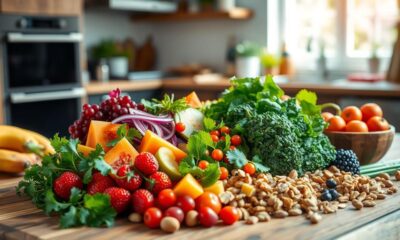
 Health and Wellness2 months ago
Health and Wellness2 months agoDoes Eating Raw Food Help You Lose Weight? Discover the Truth
-
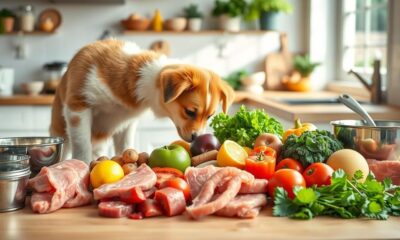
 Raw Food Recipes2 months ago
Raw Food Recipes2 months agoHow Much Raw Food to Feed Your Puppy: Essential Tips
-
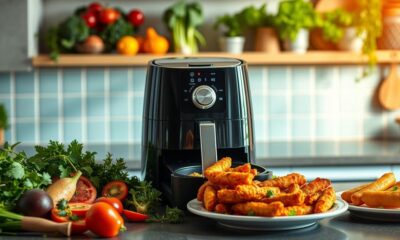
 Kitchen Essentials for Raw Food Preparation1 month ago
Kitchen Essentials for Raw Food Preparation1 month agoCan You Cook Raw Food in an Air Fryer? Discover the Possibilities
-
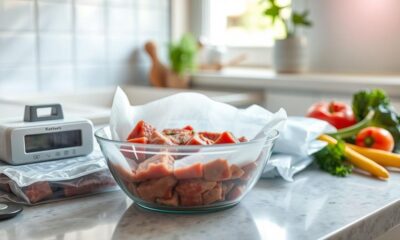
 Raw Food Recipes2 months ago
Raw Food Recipes2 months agoHow to Defrost Dog Raw Food Properly
-
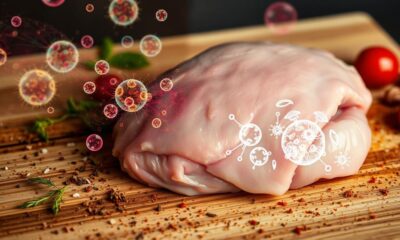
 Health and Wellness2 months ago
Health and Wellness2 months agoHow Long Does It Take Bacteria to Spread From Raw Food? Essential Info
-
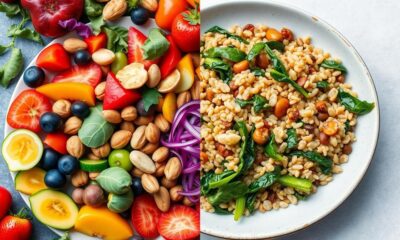
 Raw Food Recipes2 months ago
Raw Food Recipes2 months agoRaw Food Vs. Vegan: Which Diet Is Better?
-

 Raw Food Recipes2 months ago
Raw Food Recipes2 months agoIs Raw Food Good for Cats? Find Out Here
-

 Raw Food Recipes2 months ago
Raw Food Recipes2 months agoWhat Is the Raw Food Diet? A Comprehensive Overview




















